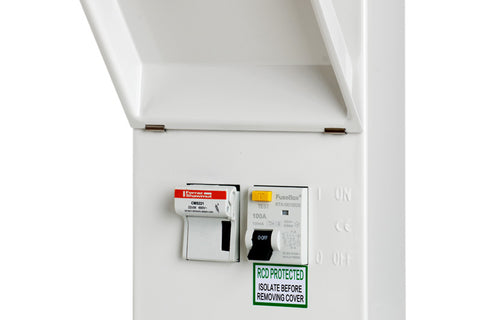RCBO FAQ
RCBO's
An RCD (Residual Current Device) provides protection against electric shock by detecting imbalances in the electrical currents. An RCBO (Residual Current Circuit Breaker with Overcurrent Protection) combines the functions of an RCD and an MCB (Miniature Circuit Breaker) in a single unit, offering both overcurrent and earth fault protection.
An RCBO provides combined protection against earth faults (such as electric shocks) and overcurrents (such as short circuits or overloads) in electrical circuits.
A RCCB (Residual Current Circuit Breaker) provides only earth fault protection, while an RCBO offers both earth fault protection and overcurrent protection in a single unit.
RCBOs offer the advantage of combined earth fault and overcurrent protection in a single device, simplifying installation and enhancing safety in electrical circuits.
One potential disadvantage of RCBOs is their higher cost compared to standalone MCBs or RCDs.
While an RCD provides earth fault protection, an RCBO may still be necessary to provide overcurrent protection in circuits where it's required by regulations or for enhanced safety.
Circuits that require both earth fault and overcurrent protection, such as socket outlets, lighting circuits, and circuits supplying electrical equipment in wet areas, may need RCBO protection.
An RCBO may trip due to various reasons, including earth faults, overcurrents, short circuits, or ground faults in electrical circuits.
Like any electrical device, RCBOs can fail due to factors such as age, wear and tear, or manufacturing defects. Regular testing and maintenance are essential to ensure their proper functioning.
The RCBO may be tripping due to an earth fault or overload condition in the lighting circuit. It's essential to investigate the cause further to rectify the issue.
RCBOs offer the combined benefits of RCDs and MCBs, providing both earth fault and overcurrent protection in a single device, thereby enhancing safety and simplifying installation.
The cost of an RCBO varies depending on factors such as brand, model, and specifications. Generally, they are more expensive than standalone MCBs or RCDs.
Electrical work, including the replacement of RCBOs, should be performed by qualified electricians to ensure safety and compliance with regulations.
The tripping time of an RCBO depends on various factors such as the magnitude of the fault current and the characteristics of the device. Generally, it should trip within milliseconds to provide effective protection.
RCBO compatibility depends on factors such as the design and specifications of the consumer unit. It's essential to ensure compatibility before installation.
RCBOs should be installed in distribution boards or consumer units, preferably near the circuits they protect, to minimize wiring distances and enhance protection.
The choice between Type A and Type B RCBOs depends on the specific application and the characteristics of the electrical loads. Type B RCBOs provide additional protection against certain types of sensitive equipment.
An RCBO can be either single-pole (for single-phase circuits) or double-pole (for two-phase or three-phase circuits), depending on the electrical installation requirements.
In certain situations and with proper evaluation of the electrical load, it may be permissible to put two circuits on one breaker. However, it's essential to ensure compliance with electrical regulations and safety standards.
Houses typically have a single main breaker or main switch that controls the entire electrical supply. However, in larger or more complex installations, multiple main breakers may be used for different sections or phases of the electrical system.
The number of sockets that can be connected to one breaker depends on factors such as the electrical load of the sockets and the capacity of the breaker. It's essential to adhere to electrical regulations and load calculations when determining the number of sockets per breaker.
In certain circumstances and with proper consideration of electrical safety, it may be permissible to install two wires under the same terminal. However, it's essential to ensure proper connection integrity and compliance with regulations.
Depending on local electrical regulations and safety standards, an outside socket may require RCBO protection to enhance safety against electric shock and overcurrents.
An RCBO includes an earth connection to provide a path for fault currents to safely dissipate, thereby reducing the risk of electric shock and ensuring proper functioning of the protection device.
Yes, grounding or earthing of electrical installations is essential for safety, ensuring that fault currents are safely discharged to the ground, thereby reducing the risk of electric shock and fire hazards.
RCBOs are commonly used in electrical installations where both earth fault and overcurrent protection are required, such as residential, commercial, and industrial settings.
Circuits that require both earth fault and overcurrent protection, such as socket outlets, lighting circuits, and circuits supplying electrical equipment in wet areas, may need RCBO protection.
The cost of an RCBO varies depending on factors such as brand, model, and specifications. Generally, they are more expensive than standalone MCBs or RCDs.
RCBOs should be installed in distribution boards or consumer units, preferably near the circuits they protect, to minimize wiring distances and enhance protection.
The regulations regarding the sale of a house with an old fuse box (consumer unit) may vary depending on local building codes and electrical standards. It's advisable to consult with a qualified electrician or regulatory authority to ensure compliance with legal requirements.












